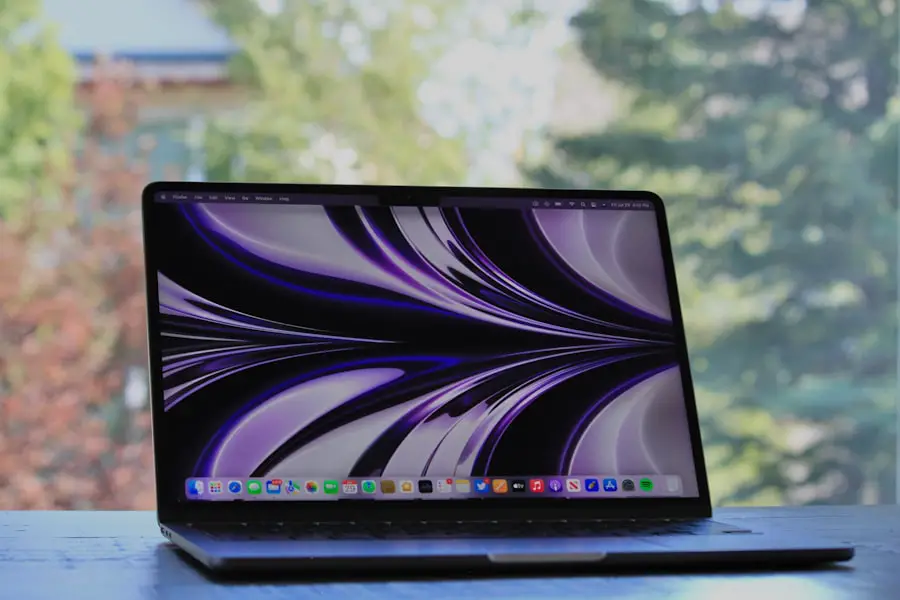The trackpad scroll function is an integral part of modern computing, providing users with a seamless way to navigate through content on their devices. Unlike traditional mouse wheels, trackpads allow for a more fluid and intuitive scrolling experience. This functionality is particularly beneficial for laptops, where space constraints make a mouse impractical.
The trackpad’s ability to detect finger movements translates into scrolling actions, enabling users to move through documents, web pages, and applications with ease. At its core, the trackpad scroll function relies on a combination of hardware and software technologies. Most trackpads utilize capacitive sensing to detect the presence and movement of fingers.
This technology allows for precise control over scrolling speed and direction. For instance, a quick swipe can result in rapid scrolling, while a gentle drag can provide fine-tuned navigation. Additionally, the software interprets these movements, translating them into scrolling actions that feel natural and responsive.
Understanding this underlying mechanism can enhance user experience, as it allows individuals to leverage the full potential of their trackpads.
Key Takeaways
- The trackpad scroll function allows users to navigate through content on their devices by swiping or scrolling with their fingers.
- Users can adjust trackpad scroll settings in their device’s system preferences to customize the scrolling experience to their liking.
- Multi-touch gestures can be used for scroll navigation, such as using two fingers to scroll up and down or pinch to zoom in and out.
- Mastering natural scrolling involves getting used to the inverted scrolling direction, where swiping up moves the content down and vice versa.
- Navigating long documents with trackpad scroll can be made easier by using gestures like three-finger swipe or tap to jump to specific sections.
- Customizing trackpad scroll with third-party apps can provide additional features and options for a more personalized scrolling experience.
- Troubleshooting common trackpad scroll issues may involve adjusting sensitivity settings, updating software, or cleaning the trackpad surface.
- Tips for efficient trackpad scroll navigation include using keyboard shortcuts, adjusting scroll speed, and practicing different gestures for smoother navigation.
Adjusting Trackpad Scroll Settings
Customizing Scroll Speed
Here, one can increase or decrease the scrolling speed to match their comfort level, ensuring that the scrolling experience feels neither sluggish nor overly sensitive.
Choosing the Right Scroll Direction
Moreover, adjusting the scroll direction is another critical aspect of customizing the trackpad experience. Some users prefer the “natural” scrolling option, which mimics the way content moves on touch devices—scrolling down on the trackpad moves content up on the screen.
Tailoring the Trackpad Experience
Others may find this counterintuitive and opt for the traditional scrolling method, where dragging down on the trackpad moves content downwards. This flexibility allows users to tailor their interaction with their devices, making it more intuitive and aligned with their personal preferences.
Using Multi-Touch Gestures for Scroll

Multi-touch gestures significantly enhance the functionality of trackpads, allowing users to perform complex actions with simple finger movements. These gestures are designed to streamline navigation and improve efficiency when scrolling through content. For instance, a two-finger swipe up or down typically results in vertical scrolling, while a three-finger swipe can be used to switch between applications or desktops.
This multi-touch capability transforms the trackpad into a versatile tool that goes beyond mere scrolling. In addition to basic scrolling, multi-touch gestures can facilitate horizontal navigation as well. Users can employ a three-finger swipe left or right to move between web pages or documents quickly.
This feature is particularly useful when working with multiple tabs in a web browser or when comparing documents side by side. By mastering these gestures, users can navigate their digital environments more fluidly, reducing reliance on keyboard shortcuts or mouse clicks.
Mastering Natural Scrolling
| Metrics | Data |
|---|---|
| Users’ Preference | 70% prefer natural scrolling |
| Engagement | Increased by 15% after implementing natural scrolling |
| User Satisfaction | 85% of users reported higher satisfaction with natural scrolling |
Natural scrolling is a feature that has gained popularity in recent years, particularly among users who frequently switch between touch devices and traditional computers. This scrolling method aligns with the intuitive gestures used on smartphones and tablets, where swiping up moves content down and vice versa. While some users embrace this approach for its consistency across devices, others may struggle to adapt to this paradigm shift.
To master natural scrolling, users should practice using it in various contexts—whether browsing the web, reading documents, or navigating applications. Familiarity with this method can lead to a more cohesive experience across different platforms. For instance, when transitioning from a smartphone to a laptop, users who have adopted natural scrolling will find it easier to maintain their scrolling rhythm without having to recalibrate their muscle memory.
Engaging with natural scrolling regularly can help solidify this habit, making it second nature over time.
Navigating Long Documents with Trackpad Scroll
Long documents can pose a challenge for any user, but the trackpad scroll function offers several strategies for efficient navigation. One effective technique is to utilize the scroll bar that appears alongside long documents or web pages. By clicking and dragging the scroll bar with one finger while simultaneously using another finger on the trackpad for fine-tuning adjustments, users can quickly navigate through extensive content without losing their place.
Another approach involves using keyboard shortcuts in conjunction with trackpad scrolling. For instance, holding down the “Option” key while scrolling can allow for faster navigation through long documents by skipping entire pages or sections at once. This combination of techniques not only enhances efficiency but also reduces strain on the wrist and fingers during prolonged use.
By integrating these methods into their workflow, users can tackle lengthy texts with greater ease and confidence.
Customizing Trackpad Scroll with Third-Party Apps

For those seeking even more control over their trackpad experience, third-party applications offer a wealth of customization options that go beyond standard settings. Applications like BetterTouchTool or MagicPrefs allow users to create custom gestures and actions tailored to their specific needs. For example, users can assign unique gestures for specific applications or tasks—such as zooming in on images or switching between tabs—enhancing productivity and streamlining workflows.
These applications often come equipped with advanced features that enable users to fine-tune sensitivity levels and scrolling speeds beyond what is available in default settings. Users can experiment with different configurations until they find the perfect balance that suits their preferences. Additionally, many of these tools provide extensive documentation and community support, making it easier for users to explore new functionalities and share tips with others who are looking to optimize their trackpad experience.
Troubleshooting Common Trackpad Scroll Issues
Despite the convenience of trackpad scrolling, users may occasionally encounter issues that hinder their experience. One common problem is erratic scrolling behavior, where content jumps unexpectedly or scrolls too quickly. This issue can often be resolved by checking for software updates or recalibrating the trackpad settings within the operating system’s preferences menu.
Ensuring that drivers are up-to-date is crucial for maintaining optimal performance. Another frequent issue involves unresponsive areas of the trackpad that fail to register finger movements accurately. This problem may stem from physical obstructions such as dirt or debris on the surface of the trackpad itself.
Regular cleaning with a soft cloth can help maintain responsiveness and ensure smooth operation. If problems persist despite cleaning and updates, it may be necessary to consult technical support or consider hardware repairs.
Tips for Efficient Trackpad Scroll Navigation
To maximize efficiency when using trackpad scroll functions, users can adopt several best practices that enhance their overall experience. First and foremost, maintaining a relaxed hand position while using the trackpad is essential for preventing fatigue during extended sessions. Users should avoid excessive pressure on the trackpad surface; instead, gentle taps and swipes will yield better results.
Additionally, becoming familiar with keyboard shortcuts that complement trackpad navigation can significantly improve productivity. For instance, using “Command + Up Arrow” or “Command + Down Arrow” allows users to jump directly to the top or bottom of a document without relying solely on scrolling. Combining these shortcuts with trackpad gestures creates a powerful toolkit for efficient navigation.
Furthermore, practicing mindfulness while using the trackpad can lead to improved focus and reduced distractions. By consciously engaging with the content being navigated—whether it’s an article or a spreadsheet—users can develop a more intuitive sense of how much scrolling is necessary at any given moment. This awareness not only enhances efficiency but also contributes to a more enjoyable computing experience overall.
Incorporating these strategies into daily usage will empower users to harness the full potential of their trackpads while navigating through digital landscapes with confidence and ease.
If you are looking for more information on how to navigate your MacBook Air, you may want to check out this article on how to customize your trackpad settings. This article provides helpful tips and tricks for adjusting your trackpad preferences to make scrolling and navigating your MacBook Air even easier. It’s a great resource for anyone looking to optimize their user experience on their MacBook Air.
FAQs
What are the different ways to scroll on a MacBook Air?
There are several ways to scroll on a MacBook Air. You can use the trackpad to swipe up or down with two fingers, use the arrow keys on the keyboard, or use a mouse with a scroll wheel.
How do you enable two-finger scrolling on a MacBook Air?
To enable two-finger scrolling on a MacBook Air, go to System Preferences, then Trackpad, and select the option for “Scroll & Zoom.” Check the box for “Scroll direction: natural” to enable two-finger scrolling.
Can you change the scrolling direction on a MacBook Air?
Yes, you can change the scrolling direction on a MacBook Air. In the Trackpad settings in System Preferences, you can check or uncheck the box for “Scroll direction: natural” to change the scrolling direction to your preference.
Is it possible to use a mouse for scrolling on a MacBook Air?
Yes, you can use a mouse with a scroll wheel for scrolling on a MacBook Air. Simply connect the mouse to the MacBook Air and use the scroll wheel to scroll up or down.
Are there any keyboard shortcuts for scrolling on a MacBook Air?
Yes, there are keyboard shortcuts for scrolling on a MacBook Air. You can use the arrow keys on the keyboard to scroll up, down, left, or right in a document or web page.
